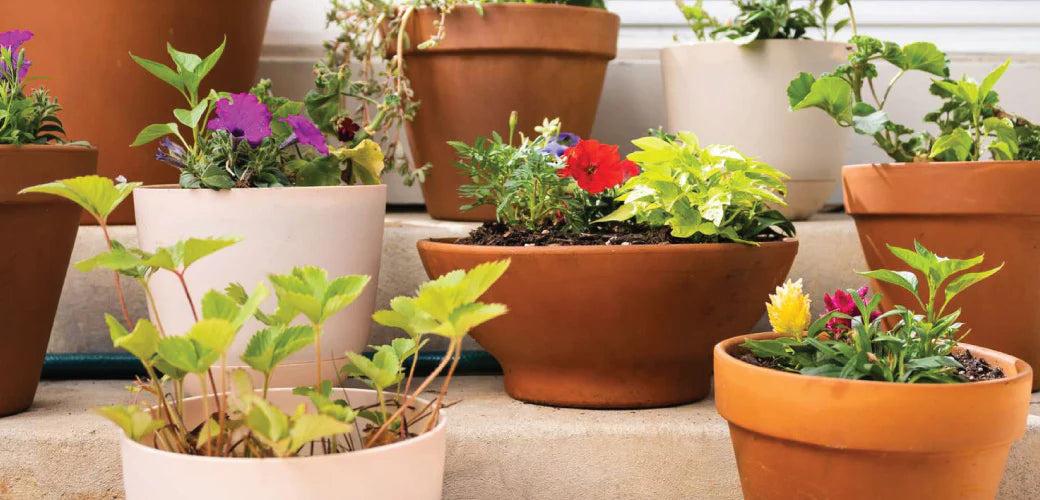As the days get longer and the stores beckon with ready-to-go summer bulbs, you’ll be tempted to start planting into those flower pots. Not sure how?
Don’t hold back! Here's a handy step-by-step guide to kickstart your spring and summer garden. First, find out how to plant in flower pots (AKA container gardening).
Why Flower Pots Are a Good Idea
A ready supply of flower pots and potted plants is an excellent addition to any home for so many reasons:
- They're the perfect solution for small yards, balconies and awkward corners
- Use them to decorate paved areas and porches too
- Flower pots are a flexible solution for redecorating as they’re portable, allowing you to add pops of colour or greenery to various parts of your home
- Potted plants are also a good solution when Summer flowering plants need to be protected from extreme weather - making it easy to move them indoors when it's frosty or even too warm
- Keeping certain aggressive species of plants in pots is beneficial to the surrounding gardens as they prevent overcrowding in your flower beds
1. What Makes a Good Flower Pot?
So let’s begin by considering the various containers you can use for potting plants.
Conventional Flower or Plant Containers

You can get conventional pots in garden centres in various sizes and conventional materials such as plastic, terracotta, fibreglass, glazed ceramics or even concrete.
Choosing the right one depends on the size of your plant and the decorative theme and colour palette of your outdoor spaces.
Build Your Plant Boxes or Beds
Alternatively, you build in. your mini beds or window boxes
Recycle or Upcycle a Container
Increasingly the sustainable approach of upcycling found, discarded or salvaged items can lend a creative or whimsical flair to your garden. This is incredibly decorative when you add a splash of colour or find something colour to use.
Examples of items upcycled into flowers can include
- Old wellies
- Old teapots
- Sinks and basins
- Old metal buckets and containers
- Lined pallets mounted vertically on a garden wall
- Lined crates
In fact - it could be anything if you have the imagination to re-use it.
Essential notes for every container
- Remember - to ensure sufficient drainage at the bottom of the container. This may mean drilling holes in any upcycled objects
- Your container must also be weatherproof and not liable to rack in extreme weather. In cold climates, beware of terracotta pots and check these are frostproof when purchasing
- Ensure the size of your container is appropriate - not too small for the root ball to develop and not too big for a single specimen. If it is too big, a waterlogged solid may lead to the rotting of the root ball
2. Line the Base
To improve drainage and prevent the soil from washing out through your drainage holes at the base of the pot, line the bottom with broken shards or roughly hewn flat stones to create a loose barrier.
3. Potting Requires the Right Compost
Good compost is your first ingredient for the perfect potting recipe.
You can make your own compost using a good composter in your yard. In this case, sieve the compost first before potting with it.
Or source some fresh multi-purpose compost from the store. Why compost? It delivers a clean, pest-free, nutrient-rich base. There is also purpose-built potting compost.
How to Fill your Pot with Compost

- After filling the base with shards or rocks, layer in the compost at the bottom and along the sides, leaving enough hollow place for the root ball
What to ADD to the Compost
- You can add water retention granules to keep the compost moist to prevent drying up in the compost in hot summer weather, you can add water retention granules to keep the compost moist
- Like water, potted plants have less access to a ready source of nutrients once the compost is depleted. This means embedding slow-release fertiliser pellets when potting or adding liquid feed every 2 weeks is necessary to keep your plants healthy and lush
4. What NOT To Use When Potting Plants
Avoid soil taken directly from your garden for the following reasons.
It may be too depleted or infected. Garden soil may also be too heavy or clay-rich.
Using soil may also contain other seeds, especially seeds from weeds that may be lying dormant. In addition, pests and other harmful minibeasts may inadvertently be transported in the process.
5. How To Transplant Your Potted Plant

When inserting your plant ready for potting, be as gentle as possible.
Here’s a sequence of steps to keep you on the right track
- Lift the plant, ready to be potted, from its previous container whilst taking care not to damage the root ball. Spread the roots out gently with your fingers without tearing most of them
- When inserting the plant into the new container - ensure the top of the rootball reaches the top surface of the compost
- Once transplanted, gently press down on the compost to firm up the base. This will establish the plant and remove large air pockets
- Provide a bit more compost, if necessary, to improve the supporting density of the compost around your new plant. Just ensure that there is about min 2.5cm from the top of the container to the compost surface level
- To stabilise further, remove more air pockets and help the roots settle in, water it well before placing it in a suitable sunny or well-lit area, especially if the plant species requires lots of light
- Some plant species require a cooler shadier spot, so do check
- When the plant gets more extensive, you must repot to a larger container to provide sufficient nutrition and space for the root ball to develop. Early spring is usually a good time to do this
6. Water Potted Plants Consistently

Unless it has been raining heavily, be sure to water potted plants on a consistent regular basis. This is especially important during the hot sunny summer days. You can reduce this consistency during winter months.
If your plants are moved indoors and subject to heating inside, you must check for dehydration even in the winter.
Your potted plant will drain well in the proper container, which means it cannot pull in water from greater depths once the soil is dry.
Your Potting Project Shopping list
Here’s a handy list of items to get this gardening adventure off the ground!
- Flower pots / upcycled containers
- Spade, Fork and Trowel set
- Floor pads or gardening knee pads
- Gardening gloves
- Multi-Purpose Compost or potting compost
- Water retaining granules
- Watering can
- Slow release Fertiliser pellets
- Liquid fertiliser feed
- Seeds and bulbs for seasonal plants or ready-grown plants from the garden centre
What’s Your Fav Flower Pot Advice?
Have you got some great advice to share and some tried and tested techniques worth adding? Let us know!


